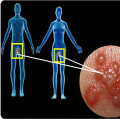Flu-like symptoms can be difficult to diagnose and understand. It can be especially confusing when you don't know what to look for, or if you are unsure of the cause. Although flu-like symptoms can be caused by a variety of conditions, it is important to be aware of them in order to get the best possible treatment. In this article, we will discuss the common symptoms of flu-like illness, as well as how to identify and differentiate between different types of flu-like symptoms.
Flu-like Symptoms
are a wide range of symptoms that can be caused by many different illnesses.Common flu-like symptoms include fever, chills, body aches, fatigue, and coughing. It's important to know the difference between the flu and other illnesses that cause flu-like symptoms so that you can get the appropriate treatment. What are common flu-like symptoms? The most common flu-like symptoms include fever, chills, body aches, fatigue, coughing, sore throat, runny nose, headache, and muscle aches. Other less common symptoms may include nausea, vomiting, diarrhea, and loss of appetite.
What illnesses can cause flu-like symptoms? Flu-like symptoms can be caused by a variety of illnesses including the flu (influenza), colds, respiratory infections such as bronchitis and pneumonia, and other viral infections such as mononucleosis. Bacterial infections such as strep throat can also cause flu-like symptoms. How are flu-like symptoms diagnosed? In order to diagnose flu-like symptoms, your doctor may order a blood test or nasal swab to test for viruses or bacteria. They may also ask you questions about your symptoms and medical history to help narrow down the possible causes of your illness.
What treatment options are available for flu-like symptoms? Treatment for flu-like symptoms depends on the underlying cause of the illness. For viral infections such as the flu or a cold, treatment may involve rest, fluids, over-the-counter medications to reduce fever and pain, and decongestants to help with congestion. For bacterial infections such as strep throat, antibiotics may be prescribed. How can flu-like symptoms be prevented? The best way to prevent flu-like symptoms is to get a yearly flu vaccine and practice good hygiene such as washing your hands frequently and avoiding close contact with people who are sick.
It's also important to get plenty of rest, eat a healthy diet, and exercise regularly in order to stay healthy and prevent illness.
Preventing Flu-Like Symptoms
Although there is no guaranteed way to prevent flu-like symptoms, there are some steps you can take to reduce your risk of getting sick. First and foremost, it is important to get vaccinated against the flu each year. Vaccines are the best way to protect yourself and your loved ones from the flu.In addition to getting vaccinated, it is important to practice good hygiene habits such as washing your hands often, covering your mouth and nose when you sneeze or cough, and avoiding close contact with people who are sick. It is also important to avoid touching your eyes, nose, and mouth, as this is a common way for germs to spread. Finally, it is important to get plenty of rest and stay hydrated to help keep your immune system strong.
Diagnosing Flu-Like Symptoms
When it comes to diagnosing flu-like symptoms, there are a variety of tests and procedures that can be used. Commonly, a doctor may order a physical examination, or a blood or urine test to determine the cause of the symptoms.Blood tests can check for the presence of antibodies or viruses associated with the flu. Urine tests can detect bacterial infections. Additionally, chest x-rays and CT scans can be used to diagnose flu-like symptoms. Other tests may be used to detect the presence of specific viruses or bacteria that may be the cause of flu-like symptoms. For example, a throat swab or nasal swab can be used to detect a respiratory virus.
A sputum culture may be taken to diagnose a bacterial infection. A lung biopsy may be necessary if pneumonia is suspected. These tests can help determine if the flu-like symptoms are caused by an infection such as the flu, or if they are due to another illness such as an allergy or asthma. Once the cause is identified, appropriate treatment can be prescribed.
Common Flu-Like Symptoms
Flu-like symptoms are a wide range of symptoms that can be caused by many different illnesses. Other common flu-like symptoms include sore throat, runny or stuffy nose, headache, and loss of appetite.In some cases, people may also experience nausea, vomiting, and diarrhea. Flu-like symptoms can be caused by viral or bacterial infections such as the common cold, influenza, or strep throat. These illnesses are highly contagious and can spread through contact with an infected person or through contact with contaminated surfaces. In addition, certain medical conditions such as autoimmune diseases and allergies can cause flu-like symptoms. If you experience any of the above symptoms, it's important to seek medical attention. Your doctor will be able to determine if you have the flu or another illness by performing a physical examination and ordering lab tests.
Treatment for flu-like symptoms usually involves rest, fluids, and over-the-counter medications to relieve fever and pain.
Treatment Options for Flu-Like Symptoms
When it comes to treating flu-like symptoms, there are a variety of options available. Depending on the cause of your symptoms, your doctor may recommend one or more of the following treatments: Rest and fluids:Getting plenty of rest and drinking plenty of fluids can help your body fight off the infection and reduce the severity of your symptoms. A humidifier may also be beneficial in helping to relieve congestion.Over-the-counter medications:
There are a variety of over-the-counter medications available to treat flu-like symptoms.These include antihistamines for allergy symptoms, decongestants for nasal congestion, and pain relievers for fever and body aches. It’s important to note that these medications don’t treat the underlying cause of your symptoms, but can help to reduce their severity.
Prescription medications:
Your doctor may prescribe antiviral medications to treat flu-like symptoms. These medications can help to reduce the severity and duration of your symptoms, as well as reduce the risk of complications.If you are prescribed an antiviral medication, it’s important to take it as directed.
Alternative treatments:
There are also some alternative treatments that may help to relieve flu-like symptoms. Some examples include herbal remedies, acupuncture, and massage therapy. It’s important to speak with your doctor before trying any alternative treatments to make sure they won’t interact with any other medications you’re taking. In this article, we discussed common flu-like symptoms, how they're diagnosed, and what treatment options are available.Fever, chills, body aches, fatigue, and coughing are all common symptoms of the flu and other illnesses that can cause flu-like symptoms. It's important to be able to distinguish between the flu and other illnesses in order to get the appropriate treatment. If you experience any flu-like symptoms, it's important to see a doctor as soon as possible for proper diagnosis and treatment. Taking preventive measures such as getting the flu vaccine, washing your hands often, and avoiding close contact with others can help reduce your risk of getting the flu or other illnesses that cause flu-like symptoms.


